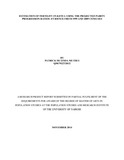| dc.description.abstract | The objective of this study was to analyze the fertility levels and trends in Kenya using the
projected parity progression ratios. It sought to establish whether the Total Fertility Rate (TFR)
computed from the projected PPRs approach is the same as the one obtained from the
conventional approach. The study pursued several objectives. The first, was determine the PPRs
for women who have completed child bearing and project the expected PPRs for younger
women. The second was to determine whether the projected PPRs for 1999 differ from the
observed PPRs 2009. The third was to compute TFR from the projected PPRs approach and
establish whether it is the same as the one from the conventional method.
Data was obtained from 1999 and 2009 censuses. The sample size was 10 percent of all the
households in Kenya in 1999 and 2009, which was 771,097 and 1,047,671 women respectively.
For completed fertility, women aged 45 to 64 years were used; while for projected fertility,
women aged 15 to 44 years were used. The main method of analysis was the projected PPRs
approach. Comparisons were made between the completed PPRs and the unprojected PPRs in
1999 as well as between projected PPRs for 1999 and observed PPRs in 2009 for the same age
cohort. Graphical methods were used to make the comparisons clearer. Further, TFR was
computed and compared from that obtained from other methods.
The findings show a slight difference in the projected and the observed PPRs for the same age
cohort in the two successive censuses. The TFR was 4.6 in 1999 and 4.4 in 2009 using the
projected PPRs approach. On the other hand, the TFR obtained using the conventional approach
for the two years respectively was 4.8 and 4.6 based on Kenya Demographic and Health Survey
(KDHS). Clearly, the absolute difference between the two estimates was 0.2, hence the two
TFRs are comparable. The main implication from the results is that if all the births in the past 12
months preceding the census date are not sampled, the TFR from the projected approach would
be lower than it should. The study recommends that a variety of methods should be used in the
calculation of TFR in Kenya, in order to compare whether the same fertility levels are arrived at.
Future studies could investigate the progression from marriages to first birth, or first birth to
marriage. | en_US |

